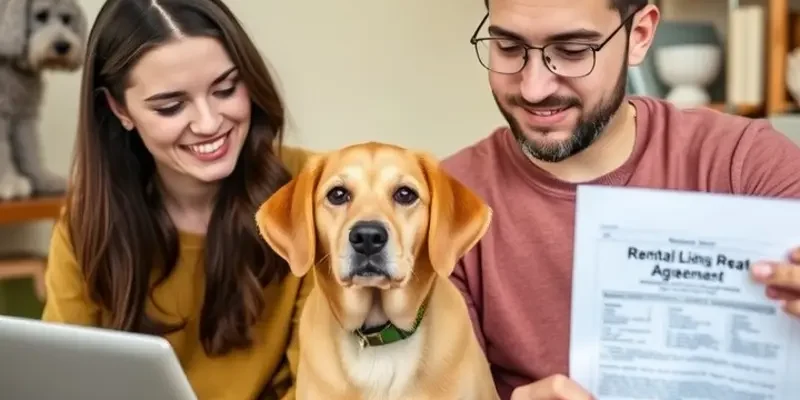Finding the perfect apartment can be especially challenging for young professionals, students, couples, and families who also have furry friends to consider. Pet rent—additional fees attached to having pets in rental properties—can quickly affect your budget and financial plans. It’s crucial to navigate these fees wisely, ensuring that you advocate for a fair amount while also finding a suitable living space. Understanding how to negotiate pet rent is an essential skill for first-time renters navigating the housing market. By approaching negotiations with insight and confidence, you can achieve financial clarity and find a home that welcomes both you and your beloved animals. This guide will equip you with practical strategies and tips on how to successfully negotiate pet rent, making the transition smoother while also strengthening your financial standing.
Understanding Pet Rent: What You Need to Know

Pet rent is a monthly fee charged by landlords to tenants who own pets, separate from the standard rent or any one-time pet deposits. This recurring fee typically ranges from $10 to $50 per month per pet, although it can be higher in luxury apartments or more pet-friendly areas. Understanding pet rent’s implications is crucial for potential renters, as it directly affects the overall cost of leasing an apartment.
For landlords, the setting of pet rent often considers multiple factors. These include the type, size, and breed of the pet, as well as the number of pets in the household. Larger animals or breeds deemed higher risk for property damage or liability might incur higher rent.
Additionally, market trends in the area and the specific policies of the apartment complex can impact pet rent levels. Some landlords might waive pet rent in highly competitive rental markets or where pet-friendly units are harder to fill. Although negotiable in some cases, renters should prepare to encounter these fees and understand how they fit into their budget plans.
Being informed about pet rent is crucial before commencing an apartment search. It ensures there are no unpleasant surprises later, and it helps in accurately calculating monthly expenses. For pet-owning renters, it’s also essential to know their rights. Under the Fair Housing Act, service and emotional support animals are generally exempt from pet rent, meaning landlords cannot legally charge the fee for these animals, although documentation might be required to verify an animal’s status.
Typical practices around the U.S. vary significantly, influenced by regional housing demand and pet-friendly culture. Cities with large populations of pet owners may offer more flexibility in terms of pet policies. For instance, some regions may provide designated pet areas and amenities, such as dog parks or grooming stations.
Understanding these aspects before starting your apartment hunt can lead to better financial planning and help avoid friction with property managers after moving in. As a pet owner, researching apartments that are genuinely pet-friendly and understand the nuances of pet rent can prevent unexpected costs and ensure a welcoming environment for your furry companions.
Exploring financial planning for renters can also be beneficial as you allocate your budget to handle such fees along with other household expenses.
Negotiation Techniques for Pet Rent

Stepping into the world of pet rent negotiation requires preparation and finesse. To successfully negotiate pet rent with your landlord or property manager, it’s essential to be well-prepared and present yourself as a dependable tenant.
Begin by gathering relevant information. Research similar rental properties in your area to understand what they charge for pet rent. This information strengthens your position by establishing a baseline. Take time to review your lease agreement’s pet policy, ensuring you are aware of all stipulations and possible leeway.
Once you have a solid understanding of your property’s market position, focus on preparing your case. Highlight factors that make you an ideal tenant. Mention consistent rental history, timely payments, and your laudable tenant record. Emphasize your commitment to maintaining the property in excellent condition, which assures landlords of your responsibility.
Addressing potential concerns from the landlord is crucial. Be proactive by presenting solutions to common issues landlords have with pets, such as possible damage or noise complaints. Provide evidence of resolved previous issues, such as a testimonial from a past landlord, if applicable.
To bolster your case, consider creating a pet resume. This document should include your pet’s name, age, breed, health records, and training certificates. Documentation addressing behavioral training can alleviate concerns about potential disturbances. Some pet owners also include references from previous neighbors, offering additional assurance.
Flexibility stands as a key component in negotiation. Be open to adjusting terms. Can you pay a slightly higher security deposit in exchange for lower monthly fees? Demonstrating a willingness to compromise might make your offer more appealing to a landlord.
Alongside flexibility, instill confidence with a demonstration of responsibility. Maintain an organized and welcoming home environment, which can be supported by organizing your apartment effectively. For practical organization tips, consider exploring this guide on apartment organization using baskets.
Meeting your landlord or property manager with a formal proposal, replete with your prepared materials, conveys professionalism. During discussions, remain polite, acknowledging their concerns while reinforcing your commitment to a mutually beneficial agreement.
Remember, the art of negotiation extends beyond convincing your landlord to waive part of the pet rent. It’s about reaching a fair middle ground where both parties feel understood and respected. Approach this process with a balanced fusion of preparation, empathy, and small victories that contribute to an improved leasing experience for both you and your landlord.
Final words
When it comes to pet rent negotiation, knowledge and preparation are your allies. By understanding what pet rent entails and employing effective negotiation strategies, you can advocate for yourself and your pet effectively. Reframing pet rent as an investment in your living situation, rather than just an added expense, can shift both your mindset and that of your landlord. Remember, being upfront and honest about your pet’s behavior, your reliability as a tenant, and showing flexibility in negotiations can lead to a successful outcome for both you and your landlord. Your furry friend deserves a happy home, and with these strategies in hand, you’ll be well on your way to making that happen.









